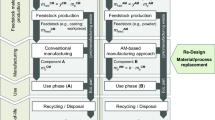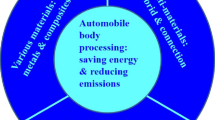Abstract
Emissions from the transportation industry combined with increasing consumption of materials have inspired the automotive industry to use lightweight materials in auto-bodies. A wide diversity of materials is being used, for example, aluminum, magnesium, and plastic composites. This light weighting approach is a proven sustainability strategy improving fuel economy and thereby reducing greenhouse gas emissions. However, increasing the number of differing types of materials in cars is actually complicating recycling operations. Critical metals used as alloying additions are dissipatively lost in the recycling process and can also negatively impact recycling rates by accumulating as tramp elements. This work combines compositional characterization of automotive materials, material flow analysis, and techno-economic assessment to better understand this problem and inform solutions. Results show that both technical solutions like sensor-based sorting and operational solutions like compositionally based blending can decrease material losses, thereby reducing the negative impacts and inching closer to a circular economy.
Access provided by Autonomous University of Puebla. Download conference paper PDF
Similar content being viewed by others
Keywords
Introduction and Background
Light weighting has been proven to be a sustainability strategy that can improve fuel economy and thereby reduce greenhouse gas emissions [3]. Aluminum , being a key material of choice for light weighting , has seen significant growth in its overall use by the automotive sector. Figure 1 shows that in the US and Canadian markets, 35% of all aluminum used in 2016 went into the transportation sector with a majority of that aluminum being used in automotive applications (with some aerospace applications as well).
Aluminum use by sector in the United States and Canada in 2016 (total usage = 12 million metric ton) [4]
Besides providing improved fuel economy, aluminum is a material of choice due to its excellent recyclability. Secondary production actually outpaces primary production in most aluminum markets. However, increasing the number of differing types of materials in cars can actually complicate recycling operations creating challenges in positive material identification and sorting which can actually lower recycling rates. Another key challenge is the increasing divergence of sources and sinks [1]. Aluminum alloys for engine castings are compositionally tolerant to a wide array of tramp or unwanted metals being carried by the aluminum scraps. Therefore, they have historically been able to have up to 100% scrap by weight. However, the use of castings in automotives has been steadily declining while other uses such as wrought , etc. are increasing. The challenge is that these wrought alloys are not as compositionally forgiving and instead have tight Aluminum Association specifications on other metals included. This means that less scrap can be incorporated to maintain the needed functional properties that the specifications are tied to. While these trends have been happening for quite some time, Fig. 2 shows some of these dynamics in just the last decade. Figure 2 shows the types of alloys produced by secondary smelters in the US. Castings include die cast alloys such as 380 variants as well as sand and permanent mold alloys such as 356 and 319. Wrought alloys are mainly extrusions and the other category captures Al -Mg, Zn, Si, Cu, Ni alloys, high purity aluminum alloys , and aluminum used for steel deoxidation. Between 2006 and 2016 cast alloys have decreased in production by 26% and wrought alloys have grown by 17%. Figure 3 shows the use of old scrap types over this same period of time; it shows about a 22% increase in old scrap being used with large gains in extrusions (+130%) and wrought scraps (+150%) and decreases in automotive shred (−50%).
Production of secondary aluminum alloys by independent smelters in the United States in metric tons [4]
US and Canada old scrap categories in 2006 and 2016 from the United States Geological Survey [4]
Beyond source-sink divergence in aluminum automotive alloys, increased usage of a diverse set of alloys has also increased the diversity of alloying elements included. Many of these alloying elements have been deemed critical by various organizations due to their importance in demand applications combined with supply concerns. Critical metals used as alloying additions are dissipatively lost in the recycling process and can also negatively impact recycling rates by accumulating as tramp elements [2, 6].
Methods
This hypothesis was tested by collecting several types of scrap alloys from various scrap yards and automotive shredding facilities in North America. Samples included both prompt and end-of-life scraps as well as both wrought and cast aluminum alloys . While many scraps were labelled with a best guess estimate for alloys by the yard inspectors, such alloy designation was not confirmed. These scraps were tested via handheld laser induced breakdown spectroscopy units (HH-LIBS ); these were not polished samples and readings were taken in at least three locations with as many as twelve readings per sample.
Results
Our work shows that these shifts in alloy use are creating problematic elements that historically were not tracked as routinely. For example, silicon , iron, copper , magnesium , and zinc are common alloying additions that accumulate and appear as tramp elements that are problematic to producing wrought alloys. Recently, other elements such as vanadium, titanium, manganese , and nickel are becoming more problematic to blending decisions. Figure 4 shows vanadium content for several prompt wrought aluminum alloys . While still relatively low, these results indicate that depending on the blending decision made, it would be possible to melt alloys together that would result in batches exceeding many vanadium specifications for wrought aluminum alloys . Such results are supported by other studies that have quantified similar increases in such tramp elements [5].
Other preliminary results also show that both technical solutions like sensor-based sorting and operational solutions like compositionally based blending and tolling can decrease material losses, thereby reducing the negative impacts and inching closer to a circular economy .
Conclusions
The use of aluminum as a light-weight material in auto-bodies has shown a continuously increasing trend. This has led to the use of a diverse range of alloying elements to improve and enhance properties. Recent studies have shown that these alloying elements accumulate as tramp elements in the recycle stream, complicate recycling operations and thereby transfer blame for the environmental impact from fuel use in traditional vehicles to that from low recycling rate of light-weight vehicles.
Our work, using compositional characterization and techno-economic assessment has shown the presence of these tramp elements in end-of-life scraps and thus hinting at the necessity of effectively implementing compositionally based blending and other operational solutions to decrease material losses and inch closer to a circular economy .
References
Gaustad, G., E. Olivetti and R. Kirchain (2010). Towards Sustainable Material Usage: Investigating Limits to Secondary Aluminum Sinks. TMS: The Minerals, Metals, and Materials Society, Seattle, WA.
Gaustad, G., E. Olivetti and R. Kirchain (2011). “Toward Sustainable Material Usage: Evaluating the Importance of Market Motivated Agency in Modeling Material Flows.” Environmental Science & Technology 45(9): 4110–4117.
Kim, H. C. and T. J. Wallington (2013). “Life-cycle energy and greenhouse gas emission benefits of light weighting in automobiles: review and harmonization.” Environmental science & technology 47(12): 6089–6097.
USGS (2016). Mineral Commodity Summaries 2016. D. o. t. Interior, United States Geological Survey. 2016.
Wagstaff, S. R. (2018). “The impact of recycling on the mechanical properties of 6XXX series aluminum alloys.”
Zimmermann, T. and S. Gößling-Reisemann (2013). “Critical materials and dissipative losses: A screening study.” Science of The Total Environment 461(Supplement C): 774–780.
Author information
Authors and Affiliations
Corresponding author
Editor information
Editors and Affiliations
Rights and permissions
Copyright information
© 2019 The Minerals, Metals & Materials Society
About this paper
Cite this paper
Arowosola, A., Gaustad, G., Brooks, L. (2019). Aluminum Alloys in Autobodies: Sources and Sinks. In: Chesonis, C. (eds) Light Metals 2019. The Minerals, Metals & Materials Series. Springer, Cham. https://doi.org/10.1007/978-3-030-05864-7_171
Download citation
DOI: https://doi.org/10.1007/978-3-030-05864-7_171
Published:
Publisher Name: Springer, Cham
Print ISBN: 978-3-030-05863-0
Online ISBN: 978-3-030-05864-7
eBook Packages: Chemistry and Materials ScienceChemistry and Material Science (R0)








